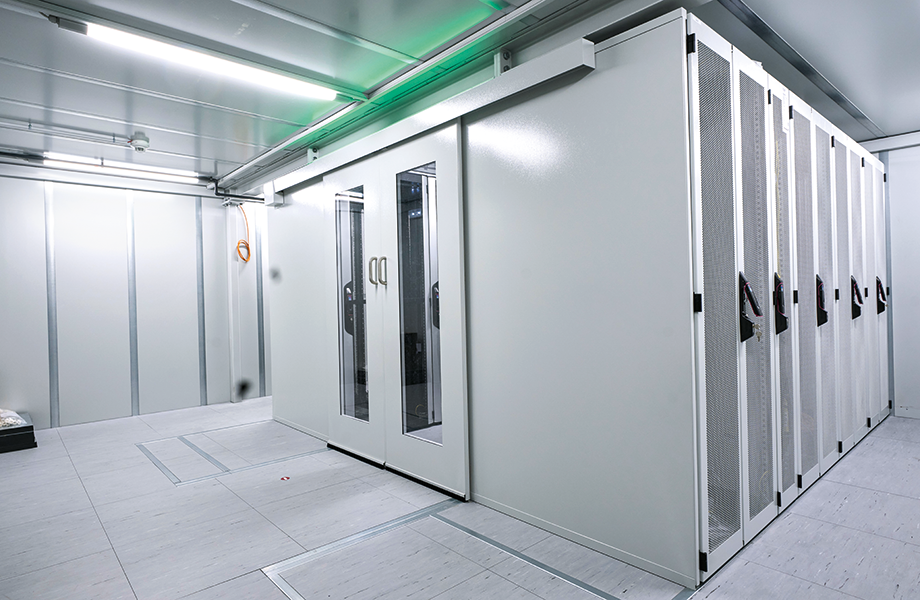Text Harald Lutz ––– Photography
Never change a running system – IT managers still firmly believe in this old pearl of wisdom. If a new data centre does need to be built, however, it often means entering completely uncharted territory. After all, projects of this magnitude and relevance are not part of the normal day-to-day work of IT managers. Once the decision to build a new data centre has been taken, the fundamental question is whether to plan a customised design from scratch or opt for a standardised solution. In the experience of Dr Armin Ortlam, Head of IT Strategy KHZG Controlling (KHZG = Hospital Future Act) at the hospital, there is no shortage of arguments against planning from scratch.
REDUCED OUTLAY AND COMPLEXITY
As he sees it, the imponderables resulting from the large number of people involved – such as architects, technical specialists and data centre experts – are partly responsible for making a lot of things more expensive than they really need to be and thus more difficult to cost. “We therefore decided to go for a ‘ready-made’ option and ultimately found what we were looking for in the form of a room-within-a-room solution. I didn’t want us to have to concern ourselves with things such as connections to the water and power supply or cooling,” says Dr Ortlam, recalling the initial stages of the collaboration with data centre specialist Rittal.
“Nowadays, building a new data centre really doesn’t need to be as complicated as it used to be. It’s no longer necessary to spend seven figure sums or factor in unexpected developments that suddenly increase the planned project budget from one to three million euros,” he adds. According to Dr Ortlam, opting for a standardised data centre is more a case of getting everything from a single source. “A hospital merely has to provide data, water, electricity and, if necessary, refrigeration and we handle everything with just one Rittal planning specialist,” he explains.
This concept is making standardised data centres increasingly appealing, especially to small and medium-sized enterprises (SMEs). “In any case, everything went smoothly here in Stade – from logistics, planning and project management all the way through to installation and, ultimately, commissioning,” he emphasises. The renowned reliability and commitment of the Rittal project team also really helped lighten the load for Dr Ortlam. Instead of him being preoccupied day and night by his data centre redundancy project, he was therefore also able to focus on the main aspects of his actual job. “I knew we could call anyone at Rittal who was involved in the project at any time, from sales staff to the project leader, and we also always obtained solid and reliable feedback,” he comments.
MODULAR AND CERTIFIED
The core concept of the modular room-within-a-room standard solution from Rittal is to set up a certified room for the future data centre in an existing building – a room that meets all security criteria stipulated by the legislator and the relevant associations. This creates a multifunctional “shield” protecting against most physical risks relating to data centre applications. “Our Basic Protection room in Stade measures 34 square metres and, for the time being, is equipped with eight VX IT racks and the Liquid Cooling Package or LCP. We also have a special technical room measuring eleven square metres, amongst other things for the UPS, which is not itself part of the Basic Protection room. Room-within-a-room standard solutions are nothing short of ingenious, especially for existing buildings with sufficient free space. Fortunately, after a long search of the hospital’s lower floors, we found the necessary space and got the go-ahead from the management team to use this as a new data centre. It currently still provides redundant capacity but will, in the future, become our primary data centre,” explains Dr Ortlam.
Why does a data centre even need to be located in a specially equipped Basic Protection room when space is available in the basement? “The problem is that the structural fabric of a normal building with its specific masonry already falls far short of meeting the structural requirements of Germany’s Federal Office for Information Security (BSI),” reveals Dr Ortlam. Customised retrofitting would, he says, be required. “A Rittal room-within-a-room standard solution, on the other hand, complies fully with the legal criteria and requirements from the outset, and the operator has little left to do for everything else – from structural engineering and ventilation through to all the various aspects of basic IT protection,” he emphasises.
Elbe Kliniken
Located in Stade and Buxtehude, this state-of- the-art healthcare service provider treats patients in the region of northern Germany known as the Elbe-Weser triangle. Around 3,000 staff provide high- quality medical and nursing care for approximately 45,000 inpatients and over 85,000 outpatients every year. More than 20,000 operations are carried out at the hospital each year. The Elbe Kliniken academic teaching hospital forms part of the University Medical Center Hamburg- Eppendorf (UKE) and is one of the region’s largest training providers, offering around 400 places for students and trainees.
60 TO 70 PERCENT LOWER COSTS
Another big plus relates to the associated costs. “Thanks to the room-within-a-room solution, we were able to carry out our data centre redundancy project in Stade at a fraction of the cost involved in planning a customised solution from scratch, and it was also much faster,” says Dr Ortlam, who is convinced he backed the right horse from the outset. “We have so far spent around a quarter of a million euros on our project. That sounds like a lot, but if you opted to plan a customised solution from scratch, you wouldn’t get something on the same scale for less than a million,” he insists. However, the exact cost saving varies from project to project depending on the cooling medium used, the planned level of redundancy, which servers and other IT equipment are selected, etc. Dr Ortlam reveals the rule of thumb applied by the experts involved in the project: “A medium-sized hospital can achieve savings of 60 to 70 percent with a standard solution – savings that can be spent on other things.”





